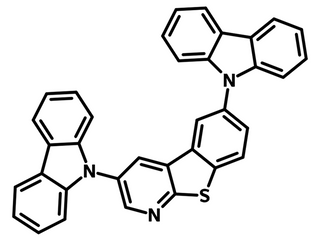DCz-BTP
CAS Number 1235883-57-4
High Purity Sublimed Materials, Materials, OLED Materials, Semiconducting Molecules, TADF Host Materials, TADF MaterialsHighly Efficient MR-TADF Bipolar Host
High purity D-A type Pyridine-fused Bipolar Host material, sublimed ≥99%
Specifications | MSDS | Literature and Reviews
DCz-BTP is an asymmetric bipolar TADF host designed for high-performance organic light-emitting diodes (OLEDs). DCz-BTP has a benzo[4,5]thieno[2,3-b]pyridine core skeleton with two electron-rich carbazole units attached. The incorporation of a pyridine fragment instead of dibenzothiophene enables strong intermolecular interactions, leading to satisfactory bipolar transporting properties. Comparing with the commonly used host materials such as mCP and DPEPO, pseudo-symmetric bipolar host DCz-BTP delivers lower driving voltage and enhanced electroluminescence performance. HF-OLEDs based on DCz-BTP host demonstrate a low turn-on voltage of 2.8 V and a maximum EQE of 20.5% using the 4TCzBN sensitizer and TBPe emitter.
Blue thermally activated delayed fluorescent OLEDs (TADF-OLEDs) based on 4TCzBN as the guest DCz-BTP as the bipolar host exhibit a low turn-on voltage of 2.8 V and a high maximum external quantum efficiency (EQEmax) of 29.0 %.
General Information
| CAS Number | 1235883-57-4 |
|---|---|
| Chemical Formula | C35H21N3S |
| Molecular Weight | 515.63 g/mol |
| Absorption | λmax 326, 339 nm (in toluene) |
| Photoluminescence | λem 399 nm (in toluene) |
| HOMO/LUMO | HOMO = - 5.63 eV, LUMO = - 2.21 eV (T1 = 2.96 eV) |
| Synonyms | 3,6-Di(9H-carbazol-9-yl)benzo[4,5]thieno[2,3-b]pyridine |
| Classification or Family | Benzo[4,5]thieno[2,3-b]pyridine derivative, MR-TADF bipolar host, Sublimed materials |
Product Details
| Purity | Sublimed ≥99% |
|---|---|
| Melting Point | Tg = 143 °C, Td = 425 °C (5% weight loss) |
| Appearance | White to light-yellow powder/crystals |
Chemical Structure

Device Structure(s)
| Device Structure | ITO/TAPC (40 nm)/TCTA (10 nm)/mCP (5 nm)/3.0 wt.% Ir(ppy)2(acac):DCz-BTP (20 nm)/4,6DCzPPM (5 nm)/TmPyPb (30 nm)/LiF (0.8 nm)/Al (100 nm) [2] |
|---|---|
| Color |
|
| CIE Coordinates | (0.29, 0.65) |
| Turn-on Voltage (Von) | 2.9 eV |
| Max Power Efficiency | 91.0 lm W-1 |
| Max EQE | 23.2% |
MSDS Documentation
Literature and Reviews
- F. Wang et al. (2022); Intramolecular C−H Activation as an Easy Toolbox to Synthesize Pyridine-Fused Bipolar Hosts for Blue Organic Light-Emitting Diodes, Angew. Chem. Int. Ed., 61 (32), e202205380; DOI: 10.1002/anie.202205380.
- F. Wang et al. (2025); Synthesis of Selenium-Doped Heteroacenes: Unveiling the External Heavy-Atom Effect in Host Materials, Angew. Chem. Int. Ed., 64 (20), e202502380; DOI: 10.1002/anie.202502380.
- U. Deori et al. (2024); A perspective on next-generation hyperfluorescent organic light-emitting diodes, Chem. Sci., 15, 17739-17759; DOI: 10.1039/D4SC05489J.
